Feisty in their flannels
Player profiles of the Indian cricketers who played in India's first Test against England in 1932
Cricinfo staff
25-Jun-2007
They were a motley crew, with diverse backgrounds and experience, but one unified by their passion for the game and pride in representing a resurgent nation. Cricinfo portrays the XI who represented India in their first Test at Lord's.
|
|
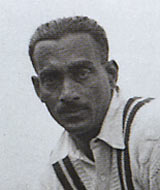
|
C K Nayudu was India's first superstar cricketer. Tall and well proportioned, Nayudu was especially strong in driving, bowled accurately at slow-medium pace and was a fine fielder. He also shone at hockey and association football. He led from the front in the inaugural Test when, despite a painful hand injury received when fielding, he top-scored with 40, in the first innings. With six centuries, the highest of which was 162 against Warwickshire, he headed the batting averages for all matches with 37.59 and took 79 wickets. He also played in three Tests against England in 1933-34 and three in the tour of 1936, when he again exceeded 1,000 runs and dismissed 51 batsmen in first-class fixtures. While still at Hislop Collegiate High School, Nagpur, he captained both the school team and Modi Club. In 1926-27 at Bombay, he gained prominence by hitting 153 (including 11 sixes and 13 fours) out of 187 in just over a hundred minutes for Hindus against AER Gilligan's MCC team. Though never on the winning side in a Test match, he helped Vizianagram defeat DR Jardine's powerful MCC side in 1933-34 - their only loss of the tour - by 14 runs, taking four wickets for 21 in the second innings. He died at Indore in 1967, aged 72.
|
|
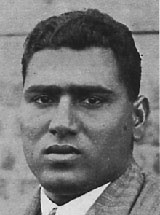
|
Mohammed Nissar
Mohammed Nissar was India's first pace bowler, possible one of the fastest they have ever produced, and one of the best too. A bull of a man, Nissar could swing and cut the ball with verve, but it was his express speed that marked him out from his peers. Of his 25 Test victims, 13 were bowled or leg-before, testimony enough to his sheer pace. Nissar's partnership upfront with Amar Singh was as legendary as it was successful. In India's maiden Test at Lord's in 1932, he plunged the England innings into disarray by knocking over the stumps of Holmes and Sutcliffe, who only ten days earlier had added 555 for the first wicket for Yorkshire, and ended with 5 for 93. On that trip, he grabbed 71 wickets at 18.09 to head the averages. The MCC tour in 1933-34 provided the setting for more heroics as he took another innings bag of five in the inaugural Test in India at the Brabourne Stadium. The only defeat that was inflicted upon the visitors on that tour was also courtesy of Nissar, whose match figures of 9 for 117 helped Vizzy XI to a 14-run victory at Benares.
Mohammed Nissar was India's first pace bowler, possible one of the fastest they have ever produced, and one of the best too. A bull of a man, Nissar could swing and cut the ball with verve, but it was his express speed that marked him out from his peers. Of his 25 Test victims, 13 were bowled or leg-before, testimony enough to his sheer pace. Nissar's partnership upfront with Amar Singh was as legendary as it was successful. In India's maiden Test at Lord's in 1932, he plunged the England innings into disarray by knocking over the stumps of Holmes and Sutcliffe, who only ten days earlier had added 555 for the first wicket for Yorkshire, and ended with 5 for 93. On that trip, he grabbed 71 wickets at 18.09 to head the averages. The MCC tour in 1933-34 provided the setting for more heroics as he took another innings bag of five in the inaugural Test in India at the Brabourne Stadium. The only defeat that was inflicted upon the visitors on that tour was also courtesy of Nissar, whose match figures of 9 for 117 helped Vizzy XI to a 14-run victory at Benares.
Another compelling demonstration of his hostility came against Jack Ryder's Australians on their tour of India in the winter of 1935. Thirty two wickets in four 'Tests' at 13 runs apiece spoke volumes for the damage he unleashed. On his final tour of England, Nissar departed the Test scene with a devastating spell that yielded four wickets in five overs to send England hurtling from 422 for 3 to 463 for 7. He continued to entertain domestic audiences for a while longer and helped Southern Punjab to the Ranji Trophy final in 1938-39 taking 17 wickets at 11.94, including a tour de force of 6 for 17 against Sind in the semis that sent them packing for 23.
|
|
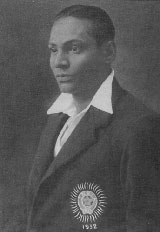
|
Amar Singh
"There is no better bowler in the world today than Amar Singh,'' said Len Hutton in an informal chat with pressmen at Madras in 1970. It was 34 years since the legendary England opening batsman had faced the Indian medium pace bowler while playing for Yorkshire. And it is the perfect tribute to Amar Singh that Hutton still remembered the hard time that the Indian, then a member of the 1936 Indian team, gave him. Another England great Wally Hammond described Amar Singh's bowling as "he came off the pitch like the crack of doom". Indeed, Amar Singh, along with Mohammad Nissar was the first great Indian bowler renowned for his accuracy, stamina and ability to make the ball move alarmingly off the air or cut it devastatingly off the pitch. He played in all the seven Tests before the war. In the first Test in 1932 he took four wickets and hit an attacking 51, coming in at No 9. Against England in 1933-34, he was the country's best bowler taking 4 for 106 off 54.5 overs in the second Test at Calcutta. In the final Test at Madras, in the absence of Nissar, he had to work overtime and rose to the occasion with a bag of 7 for 86 off 44.4 overs in the first innings. Going in at No. 4, he scored a hard hitting 48. In 1932, he took 111 wickets (20.78) and made 641 runs (22.89) in the first-class matches.
"There is no better bowler in the world today than Amar Singh,'' said Len Hutton in an informal chat with pressmen at Madras in 1970. It was 34 years since the legendary England opening batsman had faced the Indian medium pace bowler while playing for Yorkshire. And it is the perfect tribute to Amar Singh that Hutton still remembered the hard time that the Indian, then a member of the 1936 Indian team, gave him. Another England great Wally Hammond described Amar Singh's bowling as "he came off the pitch like the crack of doom". Indeed, Amar Singh, along with Mohammad Nissar was the first great Indian bowler renowned for his accuracy, stamina and ability to make the ball move alarmingly off the air or cut it devastatingly off the pitch. He played in all the seven Tests before the war. In the first Test in 1932 he took four wickets and hit an attacking 51, coming in at No 9. Against England in 1933-34, he was the country's best bowler taking 4 for 106 off 54.5 overs in the second Test at Calcutta. In the final Test at Madras, in the absence of Nissar, he had to work overtime and rose to the occasion with a bag of 7 for 86 off 44.4 overs in the first innings. Going in at No. 4, he scored a hard hitting 48. In 1932, he took 111 wickets (20.78) and made 641 runs (22.89) in the first-class matches.
By 1936 he was a popular Lancashire League professional and was released only for a few games for the Indian touring team. In the first Test, he took 6 for 35 in the first innings. In the second Test he again displayed his batting prowess by hitting an unbeaten 48 to help India draw the game. In the final Test at the Oval he scored a valuable 44 going in at No. 4 thus proving beyond doubt that he could be classified as an allrounder. At home, he was at his best against Lord Tennyson's team in 1937-38 when he bagged 36 wickets (16.66) in the five unofficial Tests. In a short but brilliant Ranji Trophy career for Western India and Nawanagar he took 105 wickets at 15.56 apiece.
He died in 1940 at the age of 29 after a fever contracted after a long swim developed into typhoid.
Janardhan Navle
India's first Test wicketkeeper, JG Navle, put in a courtly display on the 1932 tour of England, Cardus being impressed by his "polished, quicksilver" work. According to Christopher Martin-Jenkins' Who's Who of Test Cricketers, Jack Hobbs rated Navle in the same league as George Duckworth and Bert Oldfield, which is high praise indeed. Forty-one dismissals came his way on that trip, only one of them (Douglas Jardine) in the one-off Test at Lord's. He also doubled up as opening batsman, and faced the historic first delivery of India's first Test innings from Bill Bowes.
India's first Test wicketkeeper, JG Navle, put in a courtly display on the 1932 tour of England, Cardus being impressed by his "polished, quicksilver" work. According to Christopher Martin-Jenkins' Who's Who of Test Cricketers, Jack Hobbs rated Navle in the same league as George Duckworth and Bert Oldfield, which is high praise indeed. Forty-one dismissals came his way on that trip, only one of them (Douglas Jardine) in the one-off Test at Lord's. He also doubled up as opening batsman, and faced the historic first delivery of India's first Test innings from Bill Bowes.
Navle's only other Test appearance was at Bombay in 1933-34 after which he was dropped at the age of 31 to accommodate a younger man. Making his first-class debut in the Quadrangular at the age of 16, Navle kept wickets for Hindus for 16 straight years. He also played unofficial Tests against Arthur Gilligan's team in 1926-27 and Jack Ryder's team nine years later. However, he died a pauper, in 1979, after working as a watchman in a sugar mill in Pune.
|
|
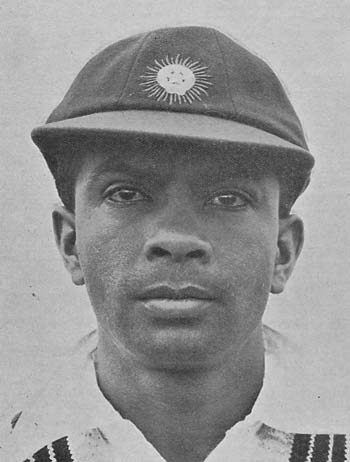
|
Naoomal Jaoomal
The man who opened the batting for India, Jeoomal Naoomal was a cautious batsman - although he once drove the first ball of a Ranji Trophy match from Mohammad Nissar for six - making 33 and 25 in the Lord's Test. When the All-India side returned there to play Middlesex, he batted for 6 1/4 hours for an unbeaten 164. Naoomal also scored a century against Derbyshire. He played in two more Test matches against England in 1933-34, making 2 and 43 at Calcutta but had a disastrous match at Madras, where a deep cut over the left eye forced him to retire for five and to miss the second innings. Besides his respectable total of 1297 runs (30.88) on the tour of England, Naoomal made his mark on Indian cricket with several centuries for Sind, 203 not out against Nawanagar in 1938 being the highest in a season when he averaged 104.50. He also made a century against Ceylon at Lahore in 1932-33. In the late 1950s he became Pakistan's coach, and passed on the fruits of his experience to such players as Hanif, Nasim and Saeed. He died in Bombay on July 18 1980, aged 76.
The man who opened the batting for India, Jeoomal Naoomal was a cautious batsman - although he once drove the first ball of a Ranji Trophy match from Mohammad Nissar for six - making 33 and 25 in the Lord's Test. When the All-India side returned there to play Middlesex, he batted for 6 1/4 hours for an unbeaten 164. Naoomal also scored a century against Derbyshire. He played in two more Test matches against England in 1933-34, making 2 and 43 at Calcutta but had a disastrous match at Madras, where a deep cut over the left eye forced him to retire for five and to miss the second innings. Besides his respectable total of 1297 runs (30.88) on the tour of England, Naoomal made his mark on Indian cricket with several centuries for Sind, 203 not out against Nawanagar in 1938 being the highest in a season when he averaged 104.50. He also made a century against Ceylon at Lahore in 1932-33. In the late 1950s he became Pakistan's coach, and passed on the fruits of his experience to such players as Hanif, Nasim and Saeed. He died in Bombay on July 18 1980, aged 76.
Syed Wazir Ali
Elder brother of S Nazir Ali, another Test player, Wazir Ali appeared in seven Test matches, all against England. He toured England in 1932 and 1936 and played against England in India in 1933. A fine batsman with a keen eye and a wide range of powerful strokes, Wazir Ali hit six hundreds during the 1932 tour and scored 1,725 in all matches. On his second visit to England he was handicapped by a finger injury. He missed a month's cricket, but although unable to do himself justice he hit the highest score for the Indians during the tour - 155 not out against an England XI at Folkestone. He led the Indian team which won matches against visiting Australian sides in 1935 and 1936. He died in Karachi in 1950, aged 46, after an operation for appendicitis.
Elder brother of S Nazir Ali, another Test player, Wazir Ali appeared in seven Test matches, all against England. He toured England in 1932 and 1936 and played against England in India in 1933. A fine batsman with a keen eye and a wide range of powerful strokes, Wazir Ali hit six hundreds during the 1932 tour and scored 1,725 in all matches. On his second visit to England he was handicapped by a finger injury. He missed a month's cricket, but although unable to do himself justice he hit the highest score for the Indians during the tour - 155 not out against an England XI at Folkestone. He led the Indian team which won matches against visiting Australian sides in 1935 and 1936. He died in Karachi in 1950, aged 46, after an operation for appendicitis.
Sorabji Colah
An attacking batsman, Colah was one of the automatic choices for the first tour of England in 1932. He did fairly well in the first-class matches but made 22 and 4 in this Test. A brilliant fielder, he picked up two catches. He also played against England at Bombay, India's next Test and the first to be played on Indian soil. Coming in late in the order, he made 31 and 12 and that remained the extent of his Test career. Colah remained a pillar for Western India, Nawanagar and Bombay during a first-class career that stretched from 1922 to 1942, making 3578 runs at an average of almost 29.08 including six centuries.
An attacking batsman, Colah was one of the automatic choices for the first tour of England in 1932. He did fairly well in the first-class matches but made 22 and 4 in this Test. A brilliant fielder, he picked up two catches. He also played against England at Bombay, India's next Test and the first to be played on Indian soil. Coming in late in the order, he made 31 and 12 and that remained the extent of his Test career. Colah remained a pillar for Western India, Nawanagar and Bombay during a first-class career that stretched from 1922 to 1942, making 3578 runs at an average of almost 29.08 including six centuries.
Nazir Ali
He did not enjoy much success, which was baffling, for he was a gifted attacking batsman. Besides, he was a medium-pace bowler, good enough to take 4 for 83 in the England second innings at Madras in the final Test of the 1933-34 series, and a splendid fielder. Nazir Ali first came into prominence with his allround efforts against Arthur Gilligan's team which visited India in 1926-27. Gilligan in fact was so impressed that he suggested that Nazir Ali should qualify for Sussex. Subsequently, he represented the county once, besides playing much cricket in England, an experience that stood him in good stead during the 1932 tour, when he made 1020 runs (average 31.87) and took 23 wickets (average 21.78). A stalwart for many years for Southern Punjab, Nazir Ali in a first-class career that stretched for 25 years, scored almost 3500 runs at an average of a little over 30. He also took more than 150 wickets. The younger brother of Wazir Ali, Nazir Ali in later years was fairly prominent in the administration of the game in Pakistan.
He did not enjoy much success, which was baffling, for he was a gifted attacking batsman. Besides, he was a medium-pace bowler, good enough to take 4 for 83 in the England second innings at Madras in the final Test of the 1933-34 series, and a splendid fielder. Nazir Ali first came into prominence with his allround efforts against Arthur Gilligan's team which visited India in 1926-27. Gilligan in fact was so impressed that he suggested that Nazir Ali should qualify for Sussex. Subsequently, he represented the county once, besides playing much cricket in England, an experience that stood him in good stead during the 1932 tour, when he made 1020 runs (average 31.87) and took 23 wickets (average 21.78). A stalwart for many years for Southern Punjab, Nazir Ali in a first-class career that stretched for 25 years, scored almost 3500 runs at an average of a little over 30. He also took more than 150 wickets. The younger brother of Wazir Ali, Nazir Ali in later years was fairly prominent in the administration of the game in Pakistan.
Phiroze Palia
Phiroze Edulji Palia played twice for India, each time at Lord's, in 1932 and 1936. Having pulled a hamstring in the field in the 1932 match, he batted at number eleven in the second innings in a vain attempt to save the match for India. Palia was a left-hand batsman, wristy and attractive, and a useful bowler of the orthodox slow left-arm type. More was expected of him in England, certainly as a batsman, than he achieved. Despite batting high in the order, in 37 first-class innings his top score was 63 against Oxford University in 1936. His highest first-class score, 216, was in the Ranji Trophy for United Provinces against Maharashtra in 1939-40. After his retirement he kept in touch with the game as a Test selector and radio commentator. He died in Bangalore on September 9, 1981, aged 71,
Phiroze Edulji Palia played twice for India, each time at Lord's, in 1932 and 1936. Having pulled a hamstring in the field in the 1932 match, he batted at number eleven in the second innings in a vain attempt to save the match for India. Palia was a left-hand batsman, wristy and attractive, and a useful bowler of the orthodox slow left-arm type. More was expected of him in England, certainly as a batsman, than he achieved. Despite batting high in the order, in 37 first-class innings his top score was 63 against Oxford University in 1936. His highest first-class score, 216, was in the Ranji Trophy for United Provinces against Maharashtra in 1939-40. After his retirement he kept in touch with the game as a Test selector and radio commentator. He died in Bangalore on September 9, 1981, aged 71,
Lall Singh
Lall Singh's chief claim to fame is that he was the first outstanding Indian fieldsman. On the tour of England in 1932 he stood out in a team in which the fielding was below average with some spectacular work in the field. An extraordinarily quick mover, it was said that "he glided over the ground like a snake". In his only Test at Lord's he scored 15 and 29 and held one catch. It was his brilliant anticipation, pick up and throw which ran out Frank Woolley in the first innings. In the second innings, with the game virtually lost, he and Amar Singh, in a thrilling counter attack, added 74 runs in 40 minutes for the eighth wicket. Singh had a short first-class career and then moved to Kuala Lumpur where he did much to foster talent and encourage the game.
Lall Singh's chief claim to fame is that he was the first outstanding Indian fieldsman. On the tour of England in 1932 he stood out in a team in which the fielding was below average with some spectacular work in the field. An extraordinarily quick mover, it was said that "he glided over the ground like a snake". In his only Test at Lord's he scored 15 and 29 and held one catch. It was his brilliant anticipation, pick up and throw which ran out Frank Woolley in the first innings. In the second innings, with the game virtually lost, he and Amar Singh, in a thrilling counter attack, added 74 runs in 40 minutes for the eighth wicket. Singh had a short first-class career and then moved to Kuala Lumpur where he did much to foster talent and encourage the game.
|
|
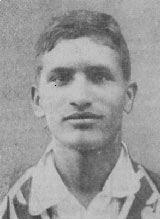
|
Jahangir Khan
The man who bowled the ball that killed a sparrow at Lord's, Dr Mohammad Jahangir Khan, 78, was a tall, fast-medium bowler and a useful right-hand batsman, Jahangir was born in Jullundur in 1910, and made his first-class debut in India for the Moslems in 1928-29. He was selected for India's first Test tour of England, in 1932, taking 4 for 60 in the second innings of the only Test, at Lord's, his distinguished victims being Holmes, Woolley, Hammond and Paynter. In all, he returned the respectable figures of 448 runs (19.47) and 53 wickets (29.05) on the tour, the highlight with the bat coming at Liverpool, where he scored 68 in adding 125 in 80 minutes for the ninth wicket with Amar Singh. He played in the three Tests of India's 1936 tour of England, but failed to take another wicket, ending his four-Test career with 39 runs (5.57) and four wickets (63.75).
The man who bowled the ball that killed a sparrow at Lord's, Dr Mohammad Jahangir Khan, 78, was a tall, fast-medium bowler and a useful right-hand batsman, Jahangir was born in Jullundur in 1910, and made his first-class debut in India for the Moslems in 1928-29. He was selected for India's first Test tour of England, in 1932, taking 4 for 60 in the second innings of the only Test, at Lord's, his distinguished victims being Holmes, Woolley, Hammond and Paynter. In all, he returned the respectable figures of 448 runs (19.47) and 53 wickets (29.05) on the tour, the highlight with the bat coming at Liverpool, where he scored 68 in adding 125 in 80 minutes for the ninth wicket with Amar Singh. He played in the three Tests of India's 1936 tour of England, but failed to take another wicket, ending his four-Test career with 39 runs (5.57) and four wickets (63.75).
From 1933 to 1936 he was up at Cambridge, winning Blues in all four years and taking 11 wickets in the 1933 match against Yorkshire. The famous 'sparrow' incident came in 1936 when he was playing for the university against MCC on July 3. Jahangir bowled to TN Pearce, and the ball struck and killed an unfortunate sparrow, which was stuffed and now occupies a display case in the Lord's museum. He continued to play first-class cricket until 1955-56, captaining Northern India in 1940-41 and 1941-42 (in which season he scored 125 not out v NWFP at Lahore). He died in Lahore on July 23.